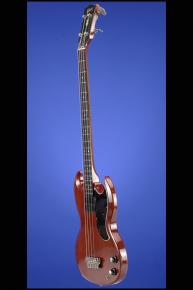One of the First SG-Style EB-0 Basses
This ultra thin (1 3/8 inches deep) SG-style bass guitar weighs just 6.90 lbs. and has a nice, fat nut width of just under 1 3/4 inches and a short scale length of 30 1/2 inches. Solid mahogany body with highly contoured edges, one-piece mahogany neck with a wonderfully thick profile, and unbound rosewood fretboard with 20 frets and inlaid pearl dot position markers. Headstock with inlaid pearl "Gibson" logo and pearl crown inlay. Two-layer (black on white) plastic bell-shaped truss-rod cover. The serial number ("14346") impressed into the back of the headstock. Two-on-a-side Kluson right-angle tuners with large cloverleaf metal buttons. One large black plastic-covered four-polepiece humbucking pickup in the neck position with an output of 32.30k. Two-layer (black on white) plastic pickguard with five screws. Lacking the original ebony finger rest on the pickguard. The metal hand rest has also been removed. Two controls (one volume, one tone) and jack socket, all on lower treble bout. Black plastic bell-shaped knobs with metal tops. Combined single-saddle bar bridge/tailpiece. The pots are dated "134 6023" (Centralab June 1960). This guitar is in excellent (8.50) condition, with a minimal amount of finish checking, a minimal amount of belt buckle wear on the back of the guitar, a couple of small marks on the top of the body, and some general edgewear. The top of the guitar and the back of the neck are slightly faded and there is a tiny split in the pickguard by the treble horn. Housed in a later brown hardshell case with light brown plush lining (8.00).
"The double cutaway shape with rounded horns proved so appealing that it was used in 1959 as the basis for a new bass called the EB-0. Pitched as a mid-priced instrument, the EB-0 was designed to revitalize Gibson's position in a market segment where success had so far eluded the company. A back-to-square-one attitude probably explains the '0' designation where the new bass would otherwise have deserved the EB-3 reference to indicate that it was actually Gibson's third electric bass. Commercially, the model succeeded the defunct EB-1 discontinued after the 1958 Summer convention. But it retained the same electronics and hardware as the EB-1, except for a newly-developed humbucking version of Gibson's original bass pickup. The humbucker variant can be identified thanks to the adjustable pole pieces relocated in the middle of the pickup cover. Like Gibson's previous basses, though, the EB-0 was built with a (short) 30.5" scale neck as opposed to the longer 34" scale of the Fender Precision Bass. In line with Gibson's new policy towards more colourful finishes, and bearing in mind the benefits of standardisation, the EB-0 was offered in the same cherry red tone as the Junior and Special. The combination of a modern shape and affordable listprice ($195.00, i.e. $40.00 less than the EB-1) contributed to the popularity of the model which rapidly showed better prospects than its predecessor. In its debut year, the EB-0 almost equalled the best score of the EB-1 and by 1960 it reached levels (342 units shipped) unheard of until then for a Gibson bass!" (A.R. Duchossoir, Gibson Electrics -- The Classic Years, p. 86).
"In Spring 1961 the EB-0 was built with the ultra thin SG-body style of the Les Paul guitars, characterized by a double cutaway with pointed horns. The body dimensions became: 12 3/4" (W) x 16" (L) x 1 5/16" (D). The basic specifications remained unchanged but for a new wing-shaped pickguard with a white revealed edge, a metal hand-rest mounted over the strings, a finger brace screwed on the pickguard and a top-mounted jack input" (A.R. Duchossoir, Gibson Electrics -- The Classic Years, p. 192). This guitar is one of 535 EB-0s shipped in 1961.
Translate:









